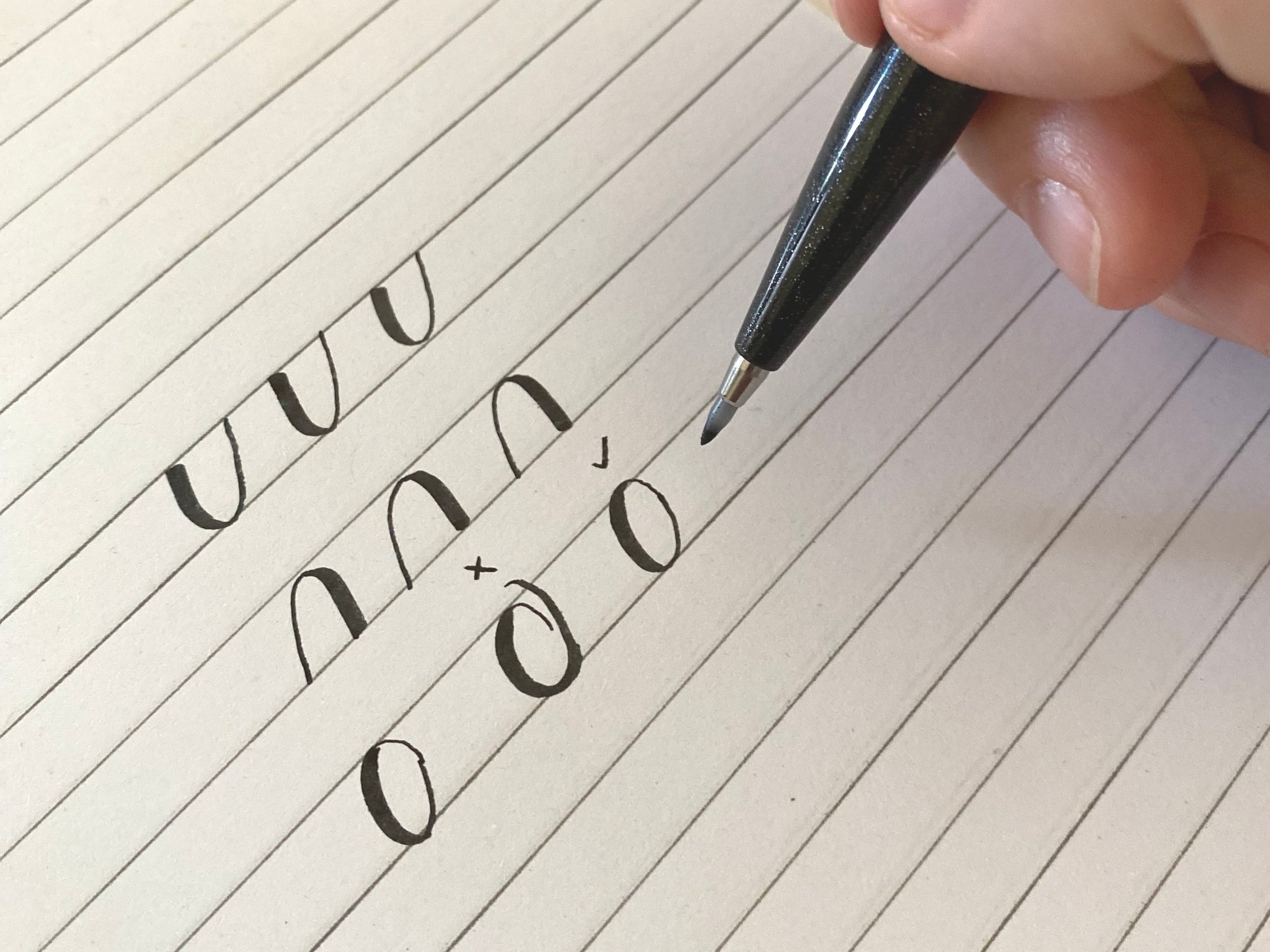How calligraphy teaches us more than beautiful writing
The mindful psychology of calligraphy - Part 1
Flashback – you’re one or two years old, perhaps this is the first time you’ve picked up a pencil or pen. No intention, just curiosity and an openess to creativity, exploring the sensations and control (or lack of) scribbling lines on a piece of paper (or a wall).
Years later, you’re at school where writing becomes a tool to communicate, to process ideas and thoughts, to create with.
For some, there’s a fascination with writing that leads them to explore different creative styles, perhaps starting to make cards, cover books in fun bubble writing (showing my age!), graffiti art, getting playful with diaries/journaling… but for many, the creative part of writing leaves us somewhere between school and work, somewhere between the “youthful mind” and the “life-just-got-serious mind”.
“As we age, it is common for our physical and functional abilities to decline. Our cognitive abilities also tend to deteriorate with age. [However] …creativity can be incorporated into prevention and therapy programs to strength cognitive capacities or well-being” - Gunnar De Winter, Medium.com
When I discovered calligraphy, it was at a time when I was struggling to cope with life. Life felt heavy. It felt exhausting. Everything was out of flow. Everything felt fast and panicked. There was no consistency, no sense of progress. Life felt blank and hopeless.
I’ve talked about the benefits calligraphy gave me from a mental and physiological point (lower heart rate, blood pressure, reduces anxiety, stress etc). But there’s more. When I teach calligraphy I’m not just teaching people the techniques to create beautiful writing. I’m teaching them tools to unlock their self-awareness. To notice, be curious, and understand the intrinsic connection between practicing calligraphy… and practicing mindfulness.
3 Things Calligraphy Teaches Us
Below are the first three of six main areas I have identified, but there’s likely to be many more you might find - small nuances that circle back to a self-reflective, self-actualisation, process.
1. Pressure
As with life, we apply different pressures on ourselves and on others. This isn’t about speed at this point, it’s more about expectations, determination and the weight we apply across our work, relationships, environment (i.e. house work), life admin.
In calligraphy we learn that every downstroke is heavy, and every upstroke is light. But what is often overlooked is that whilst the thick downstrokes stand out – consider this the negativity we carry, the weight of the day – there’s actually more thin, lighter strokes in all the letters.
So what’s the relation? We as humans have a negative bias. To keep us safe, aware of danger, we focus and pay attention to those thick, heavy downstrokes (moments) in our day. But, when you look closer, when you reflect back, there are many more joyful, lighter, upstrokes – progress, connection, kindness that we can notice.
2. Transitions
When I was in full-time employment advocating for improved wellbeing provision in the workplace, I came across something called ‘de-rolling’. It’s something that actors and musicians do to transition between their performance, coming off-stage and their journey home. For some it might be changing into different clothes, showering, listening to music, doing an activity/hobbie like stretching, meditating, or something creative. It could be a particular ritual which helps your mind and body move from one environment, from one energetic output – to another. This resonated with my experience of becoming a mother: going to work, being ‘Laura’, and coming home, being ‘Mum’. Like two hats I needed to swap over. And for many, just the moment between leaving work and coming home could be an opportunity to ‘de-roll’.
More recently I’ve noticed the speed (which we’ll come on to) at which people move through tasks, conversations, their days, their weeks and so on. But for each of these moments there are transition points, which we’re often too distracted to notice. These are sweet spots – like a biting point as you’re changing gear, or the walk from one place to another. What you do with that moment, and how you harness it can be game-changing.
It could also be seen in challenging conversations or situations – moving from a negative experience with coping mechanisms. These are all transition points for us. And they’re scattered throughout our day. Opportunities to practice, to notice, to take control.
So what’s the relationship to calligraphy? In calligraphy we learn about transitioning from a thick pressure to a thin, and the other way. We transition between letters and strokes, perhaps colours and pens. But the key is in the intention, the awareness, the breath and the speed at which we allow ourselves to transition. This is where the sweet spot is for progress. The excitement of a perfect transition in a stroke says it all (if you know, you know).
3. Momentum
A comrade to Transition – both a villain and a hero – Momentum offers drive and commitment, but equally can propel us into a flow we’re not in control of.
In calligraphy terms, this tends to occur as we transition – we speed up from thick to thin, around a curve in a stroke, or on the straight approach.
In life, we tend to need momentum to move us into action. It’s that bit just after the motivation to start the task has kicked-in. Momentum can keep us going and move us into a great flow state. However, there’s a danger of speeding up to the point of either obsession, addiction or simply not pausing to adjust, transition, decompress, reflect – or even celebrate. These could be micro-moments: within conversations, tasks, activities; or these could be macro-moments: moving house, projects-to-project, switching careers, relationships and so on.
So, for momentum, it’s the simple act of noticing. Noticing the transition points, choosing how to de-roll, taking back control, and being intentional with the next moment, stroke or letter you are creating.
How can you harness the power of these connections between calligraphy and our own life?
1. Notice the pressure. Note it down.
Remember, just with calligraphy, we need both to ensure a balance. Heavy isn’t always bad, light isn’t always possible.
a. Choose three moments in your day – perhaps mid-morning, lunchtime and afternoon. What pressure are you applying to yourself, and to others around you? Are they more heavy (Hardwork / conflict / strength / power) than light (joy/kind/fun/compassionate)? Or more light than heavy?
b. If it’s more heavy – how can you bring in more light? How can you ease some of the pressure? How can you invite more lighter energy?
2. Notice the transitions. Note it down.
Start with each day (then each week, each month) just begin to notice the small – and larger – gear change / transition point.
3. Notice the momentum. Note it down.
Whether you choose to focus on daily, weekly or monthly points, taking note of your energy / momentum of the task/project/job and how you navigate into the next moment/phase can be really useful.
You might find it easier to journal
A work situation for example, might be:
“Project X” – started slowly and built up speed and pressure to deliver this on time to the client (pressure/momentum). We’ve have completed the project, but now (transition point) in a state of fast-paced delivery (momentum) and feel anxious (pressure) to get started on the next project.
Here’s my opportunity to slow down, review, reflect, recharge and prepare for the next project.
Or, a non-work example could be:
“Holiday mode” – After two relaxing weeks off I felt like I couldn’t get motivated back into starting my new job. I should be excited and getting into my work, but feel like I’m still on holiday and sad to be back.
Here’s my opportunity to share my holiday experience with others, note down/capture my favourite memories, listen to my uplifting work playlist, put on my new work shoes, and write a short, specific, manageable to-do list to begin my day.
You may find it easier to write into a table
Have it to hand so you can notice and note in the moment. Something like this:
Look out for the next blog! In Part 2 I’ll be talking through the power of calligraphy as a single-focused activity and dropping into flow state, consistency and finding our authentic style, and the vulnerability of practise to progress. I know, told you…calligraphy can teach us so much.
For a more creative practice, learn and improve your calligraphy by join my monthly Mindful Calligraphy Club, or a course or workshop.










